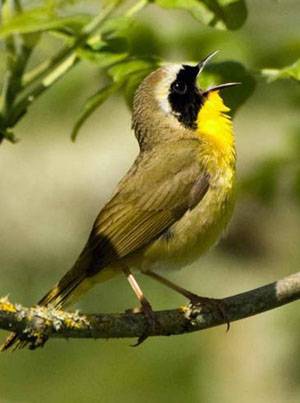 A loud, rollicking “wichity-wichity-wichity-witch” rings from a stand of cattails. After a second’s pause, another “wichity” series sounds from the other side of the marsh. These Common Yellowthroats are easy to detect, but notoriously hard to spot. The birds skulk in dense thickets of cattails, foraging for food in the debris of dead cattail leaves.
A loud, rollicking “wichity-wichity-wichity-witch” rings from a stand of cattails. After a second’s pause, another “wichity” series sounds from the other side of the marsh. These Common Yellowthroats are easy to detect, but notoriously hard to spot. The birds skulk in dense thickets of cattails, foraging for food in the debris of dead cattail leaves.
Common Yellowthroats typically feed on small insects and spiders, probing in dead vegetation and in bark crevices for hidden invertebrates. Their short wings make them weak fliers, so they typically hop from perch to perch while foraging, and they fly distances in short bursts, skimming low over thickets or marshes.
Common Yellowthroats are the only wood-warbler to breed in every contiguous state, although their habitat is rarer in the desert southwest. Because of their affinity for cattail marshes and dense, wet vegetation, Common Yellowthroats are common summer residents in the Portage Lake area. In the fall, however, northern Common Yellowthroats migrate south to Mexico; most yellowthroats are absent between October and May, when they return to claim territories once more.
Common Yellowthroats can be found in practically any dense, low-growing vegetation near water, although in Michigan, they are particularly fond of cattail marshes. In addition to being widespread, they are often extremely common locally; even a highway median ditch could harbor a Common Yellowthroat, and larger marshes can have hundreds of pairs. Common Yellowthroats’ territories range widely in size based on the strength of the male defending the territory; one Michigan study showed territory variation from 0.2 hectares to 2.9 hectares in size. Yellowthroats claim territories through song; louder, more aggressive males can defend larger territories. Yellowthroats sing throughout the breeding season. Immatures learn the distinctive “wichity-wichity-wichity” warble by hearing their parents and neighbors’ songs; occasionally, yellowthroats will learn the wrong songs, such as the yellowthroat that perfectly mimicked a Chestnut-sided Warbler’s song.
Common Yellowthroats are small birds, about 4 ½ inches long, with a short tail, often vertically cocked. Both sexes have dusty brown back and bellies with a yellow throat. Males have more extensive yellow that contrasts with a black face mask, bordered in white, along with an extra spot of yellow underneath the tail. Females are duller, lacking the black mask, white eyebrow, and yellow undertail. Immature males look like females, but they may have some black face mask feathers coming in; immature females are overall brown, with very little yellow on the throat. Common Yellowthroats can be readily distinguished from other skulking warblers by their limited yellow on the throat (other warblers have dull brown throats or extensive, uniformly yellow underparts that blend into the face) and their distinctive rounded shape. Most ground warblers appear more elongated and stand more upright. Even immature females, which lack the yellow throats, have pale throats that contrast with darker face and belly, unlike similar female warblers.
The black face mask is distinctive among male yellowthroats, and female yellowthroats rely on it to identify future mates. In one study, a researcher took a stuffed female yellowthroat and pasted a black mask onto it. Males responded aggressively until the researcher removed the black mask, when the same males then attempted to mate with the stuffed specimen. Males also choose females based on the brightness of their plumage; brighter females are more fit and can thus raise more offspring.
The origin of the common name is quite clear: this widespread and distinctly yellow-throated bird deserves the name “Common Yellowthroat.” The scientific name, Geothlypis trichas, also describes the bird’s habits: Geothlypis translates to ground-bird or ground-warbler, while trichas refers to a type of thrush. While yellowthroats are not thrushes, their skulking behavior is similar to many thrushes.
Further Reading
Click Here for information from All About Birds
Click Here for information from Birds of North America
Click Here for an animated Yellowthroat occurrence map from eBird
Click Here for information from the National Audubon Society
Click Here for a video of singing male Yellowthroats